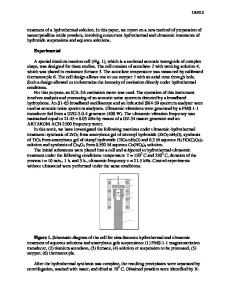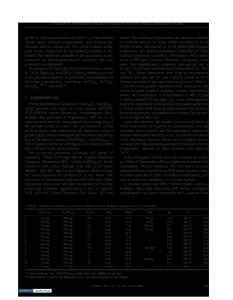Hydrothermal synthesis and sintering of ultrafine CeO 2 powders
- PDF / 886,135 Bytes
- 7 Pages / 612 x 792 pts (letter) Page_size
- 100 Downloads / 476 Views
M. N. Rahaman Ceramic Engineering Department, University of Missouri-Rolla, Rolla, Missouri 65401-0249 (Received 19 October 1992; accepted 5 March 1993)
Undoped CeO 2 and Y 2 O3 -doped CeO 2 powders, with particle sizes of —10-15 nm, were prepared under hydrothermal conditions of 10 MPa at 300 °C for 4 h. The compacted powders were sintered freely in air or in O 2 at constant heating rates of 1-10 °C/min up to 1350 °C. The undoped CeO 2 started to sinter at « 8 0 0 - 9 0 0 °C and reached a maximum density of 0.95 of the theoretical at 1200 °C, after which the density decreased slightly. Isothermal sintering at 1150 °C produced a sample with a relative density of =0.98 and an average grain size of =100 nm. The samples sintered above 1200 °C exhibited microcracking. The decrease in density and the microcracking above 1200 °C are attributed to a redox reaction leading to the formation of oxygen vacancies and the evolution of O2 gas. Doping with Y 2 O 3 produced an increase in the temperature at which measurable sintering commenced and an increase in the sintering rate, compared with the undoped CeO 2 . Sintered samples of the doped CeO 2 showed no microcracks. The CeO 2 doped with up to 3 mol % Y 2 O 3 was sintered to almost full density and with a grain size of =200 nm at 1400 °C.
I. INTRODUCTION Ultrafine-grained (or nanocrystalline) materials, characterized by a grain size of 2 powders
the yttrium ions would be expected to occupy normal cerium sites. The defect reaction for the incorporation of Y 2 O 3 may be written: Y2O3 —
2Y^ e + Vo + 2O O + 1/202.
(6)
The addition of Y 2 O 3 to CeO 2 influenced the redox reaction at high temperature because the balance between Ce 4+ and Ce 3+ can be compensated by the incorporation of Y 3 + in the normal Ce 4+ positions. For 1 mol% dopant, the redox reaction of ceria is not fully suppressed, as seen from the small kink at point A in the sintering curve (Fig. 7). The redox reaction appears to be fully suppressed in CeO 2 doped with 3 mol % Y 2 O 3 since no measurable change in the slope of the sintering curve was observed at =1200 °C. V. CONCLUSIONS Ultrafine powders of undoped CeO 2 and Y 2 O 3 doped CeO2 (particle size 10-15 nm) were synthesized under hydrothermal conditions, and the sinterability of the consolidated powders was investigated at constant rates of heating in air or O 2 . For the undoped powder, the temperature at which measurable shrinkage commenced (800-900 °C) was approximately the same as for coarser, micron-sized powder. This is very different from the published results for ultrafine TiO2 powders prepared by the inert gas condensation method, where a decrease of =600 °C was observed. For the initial stage of sintering, the densification rate showed a relatively weak dependence on the initial particle size of the powder, compared to the predictions of sintering models. The occurrence of a redox reaction at =1200 °C limited the sinterability of the undoped powder. The sintered density reached a maximum of 0.95 (of the theoretical) at this temperature and
Data Loading...











